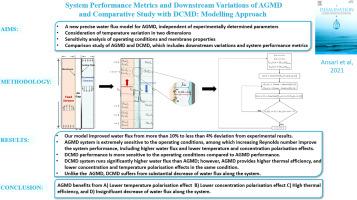Desalination ( IF 8.3 ) Pub Date : 2022-01-04 , DOI: 10.1016/j.desal.2021.115539 Abolfazl Ansari 1 , Fariba Malekpour Galogahi 1 , David V. Thiel 1 , Fernanda Helfer 1 , Graeme Millar 2 , Sofiane Soukane 3 , Noreddine Ghaffour 3

|
Air-Gap Membrane Distillation (AGMD) promises to reduce heat loss in membrane distillation. Most AGMD models are one-dimensional and do not consider the downstream variations. In addition, a linear function of vapour pressure is used, which either relies on experimentally determined parameters or a simplified mass transfer resistance to model the water permeate flux. This study introduces a new, improved model that simultaneously considers both heat and mass transfer in the AGMD process by coupling the continuity, momentum, and energy equations. A novel precise logarithmic function of vapour pressure was derived to model the water permeate flux, independent of experimentally determined parameters. By varying the inlet temperature, Reynolds number, inlet concentration, and air-gap thickness, the performance of AGMD was evaluated. The results revealed that our model improved the water flux prediction from more than 10% to less than 4% deviation from experimental results. Among the operating conditions, only increasing the Reynolds number improved all the system performance metrics, including higher water flux and lower temperature and concentration polarisation effects. Results were compared with Direct Contact Membrane Distillation (DCMD) outcomes and showed that unlike AGMD, DCMD suffers from a substantial decrease in water flux along the module. For DCMD, the exit water flux value decreased by 50% in comparison with the inlet value, while the water flux decreased by only 2% for AGMD, using a 1 mm air gap thickness.
中文翻译:

气隙膜蒸馏的下游变化与直接接触膜蒸馏的比较研究:一种建模方法
气隙膜蒸馏 (AGMD) 有望减少膜蒸馏中的热损失。大多数 AGMD 模型是一维的,不考虑下游变化。此外,使用蒸汽压的线性函数,它依赖于实验确定的参数或简化的传质阻力来模拟水渗透通量。本研究引入了一种新的改进模型,该模型通过耦合连续性、动量和能量方程同时考虑 AGMD 过程中的传热和传质。导出了一种新的精确的蒸气压对数函数来模拟水渗透通量,独立于实验确定的参数。通过改变入口温度、雷诺数、入口浓度和气隙厚度,评估了 AGMD 的性能。结果表明,我们的模型将水通量预测从实验结果的偏差从超过 10% 提高到小于 4%。在操作条件中,仅增加雷诺数就能改善所有系统性能指标,包括更高的水通量和更低的温度和浓差极化效应。结果与直接接触膜蒸馏 (DCMD) 结果进行了比较,结果表明,与 AGMD 不同,DCMD 沿模块的水通量显着降低。对于DCMD,与入口值相比,出口水通量值降低了50%,而AGMD 的水通量值仅降低了2%,使用1 mm 气隙厚度。只有增加雷诺数才能改善所有系统性能指标,包括更高的水通量和更低的温度和浓差极化效应。结果与直接接触膜蒸馏 (DCMD) 结果进行了比较,结果表明,与 AGMD 不同,DCMD 沿模块的水通量显着降低。对于DCMD,与入口值相比,出口水通量值降低了50%,而AGMD 的水通量值仅降低了2%,使用1 mm 气隙厚度。只有增加雷诺数才能改善所有系统性能指标,包括更高的水通量和更低的温度和浓差极化效应。结果与直接接触膜蒸馏 (DCMD) 结果进行了比较,结果表明,与 AGMD 不同,DCMD 沿模块的水通量显着降低。对于DCMD,与入口值相比,出口水通量值降低了50%,而AGMD 的水通量值仅降低了2%,使用1 mm 气隙厚度。DCMD 遭受沿模块的水通量的显着降低。对于DCMD,与入口值相比,出口水通量值降低了50%,而AGMD 的水通量值仅降低了2%,使用1 mm 气隙厚度。DCMD 遭受沿模块的水通量的显着降低。对于DCMD,与入口值相比,出口水通量值降低了50%,而AGMD 的水通量值仅降低了2%,使用1 mm 气隙厚度。











































 京公网安备 11010802027423号
京公网安备 11010802027423号